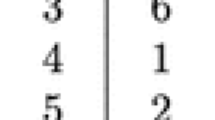Abstract
This paper describes an algorithm to find an (α-)envy-free Pareto-optimal division in the case of a finite number of homogeneous infinitely divisible goods and linear utility functions. It is used to find an allocation in the classical cake division problem that is almost Pareto-optimal and α-envy-free.
Similar content being viewed by others
References
Brams, S., Taylor, A., 1992. An envy free cake division algorithm, Mimeo, Department of Politics, New York University, New York.
Ford, L., Fulkerson, D., 1956. Maximal flow through a network. Canadian Journal of Mathematics 8, 399–404.
Gale, D., 1960. The theory of linear economic models. McGraw-Hill, New York, pp. 281–287.
Knaster, B., 1946. Sur le problème du partage pragmatique de H. Steinhaus. Annales de la Société Polonaise de Mathematique 19, 228–230.
Steinhaus, H., 1948. The problem of fair division. Econometrica 16, 101–104.
Steinhaus, H., 1949. Sur la division pragmatique. Econometrica 17 (suppl.), 315–319.
Author information
Authors and Affiliations
Rights and permissions
About this article
Cite this article
Reijnierse, J.H., Potters, J.A.M. On finding an envy-free Pareto-optimal division. Mathematical Programming 83, 291–311 (1998). https://doi.org/10.1007/BF02680564
Received:
Revised:
Issue Date:
DOI: https://doi.org/10.1007/BF02680564




